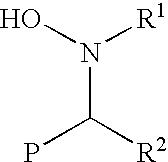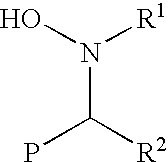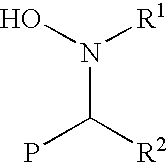Functionalization of living rubbery polymers with nitrones
a technology of rubbery polymers and nitrones, which is applied in the field of functionalization of living rubbery polymers with nitrones, can solve the problems of providing a lower level of tire rolling resistance and low polymer hysteresis, and achieves the effects of improving the affinity of fillers, improving the interaction of polymer/filler, and low cos
- Summary
- Abstract
- Description
- Claims
- Application Information
AI Technical Summary
Benefits of technology
Problems solved by technology
Method used
Image
Examples
example 1
[0048]In this experiment N-t-butylphenylnitrone was systhesized utilizing the procedure described in U.S. Pat. No. 6,762,322. In the procedure used a dry 3-liter, 3-necked, round bottom flask equipped with a mechanical paddle stirrer, a nitrogen gas flow, and a condenser was charged with 87 grams (83.5 ml; 0.82 moles) of benzaldehyde and 63 grams (90.5 ml; 0.86 moles) of t-butylamine. The mixture was stirred for about 4 hours at room temperature to allow complete formation of N-benzylidene-t-butylamine. After removal of the nitrogen gas flow and the condenser, the reaction flask was evacuated under an aspirator (about 24″ Hg vacuum) for about 15 minutes. The aspirator was detached and 288 grams (3.428 moles) of sodium bicarbonate followed by 500 ml of water and 500 ml of acetone were added to the 3-liter flask. The condenser was reattached to the flask and about 600 gm (0.98 moles) of Oxone® oxidizing agent was carefully added portion-wise through a powder-addition funnel to the sti...
examples 2 – 7
EXAMPLES 2–7
[0050]In this series of experiments living styrene-butadiene rubbers were end-group functionalized with various nitrones, compounded in carbon black and silica filled formulations, and evaluated with respect to physical properties. The living styrene-butadiene rubbers were made in a one-gallon (3.8 liter) batch reactor which was equipped with an agitator, steam heating, and glycol cooling. The polymerizations were conducted at 65° C. for two hours. The polymer specification was 75% 1,3-butadiene and 25% styrene. The polymerizations were initiated with n-butyl lithium and modified with one mole ratio of N,N,N′,N′-tetramethylethylenediamine (TMEDA) to lithium. The target Mooney large 1 / 4 range was 40–45, with an onset glass-transition temperature of approximately −35° C. All polymerizations were killed with a slight excess of the nitrone being used as the terminator (1.1:1.0 mole ratio to lithium), followed after a few minutes by a slight excess of ethanol (1.1:1.0 mole ra...
PUM
| Property | Measurement | Unit |
|---|---|---|
| temperature | aaaaa | aaaaa |
| particle diameter | aaaaa | aaaaa |
| temperatures | aaaaa | aaaaa |
Abstract
Description
Claims
Application Information
 Login to View More
Login to View More - R&D
- Intellectual Property
- Life Sciences
- Materials
- Tech Scout
- Unparalleled Data Quality
- Higher Quality Content
- 60% Fewer Hallucinations
Browse by: Latest US Patents, China's latest patents, Technical Efficacy Thesaurus, Application Domain, Technology Topic, Popular Technical Reports.
© 2025 PatSnap. All rights reserved.Legal|Privacy policy|Modern Slavery Act Transparency Statement|Sitemap|About US| Contact US: help@patsnap.com



